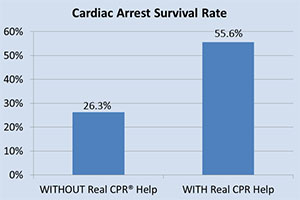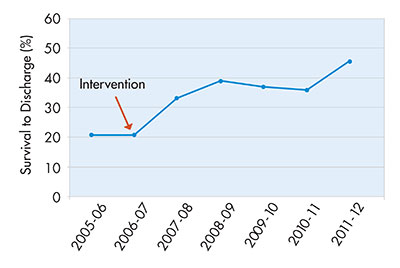Better Outcomes Realized
Data from EMS providers in Arizona and an academic medical center in California show that high-quality CPR does save lives—and that ZOLL technology helps providers deliver high-quality CPR.
Odds of Survival More than Doubled
In the pre-hospital setting, ZOLL technology and training combined to more than double the odds of survival to discharge for patients in Arizona.1 This dramatic improvement was achieved when emergency responders used ZOLL defibrillators with Real CPR Help® and CPR Dashboard™ and received specialized training. With these technologies, rescuers know if they are pushing hard enough and fast enough to meet current CPR Guidelines and also know how long they have been off the chest when compressions are paused.
As documented in Arizona, a person who suffered cardiac arrest would be 2.7 times more likely to survive if the EMS provider used Real CPR Help and received scenario-based training than a similar patient who was treated by an EMS provider with traditional CPR training and no feedback technology.1 Among study participants whose cardiac arrest was witnessed and due to ventricular fibrillation (a shockable rhythm), survival to discharge more than doubled, from 26.3% to 55.6%, using this protocol (Figure 1).
Figure 1. Survival from witnessed VF cardiac arrest in Arizona
Resuscitation Training Program Doubles Survival
The University of California, San Diego (UCSD) Medical Center is using ZOLL technology as part of an innovative and very successful advanced resuscitation training program that emphasizes the importance of preventing interruptions in CPR. The UCSD hospitals use ZOLL defibrillators with Real CPR Help, CPR Dashboard, and ZOLL’s industry-exclusive See-Thru CPR® technology, which reduces the duration of pauses in CPR by enabling providers to see the patient’s underlying cardiac rhythm during CPR. In addition, for post-code debriefing and training, the hospital uses RescueNet® Code Review.
Since implementing this program at UCSD hospitals in 2007, the incidence of cardiac arrest is down, and the survival-to-discharge rate among patients who do suffer cardiac arrest now approaches 50%, increasing from 21% to 45% (Figure 2).2 This improvement was documented in a seven-year study that ended in 2012.2 The same study found that the odds of surviving cardiac arrest with a good neurological outcome tripled.Based on these impressive results, this training program has been selected as a Joint Commission Best Practice.
ZOLL is taking the guesswork out of CPR, and patients are benefitting.
Figure 2. Survival to discharge after cardiac arrest at UCSD
1Bobrow BJ, et al. Ann Emerg Med. 2013 Jul;62(1):47–56.e1.
2Davis DP, et al. Resuscitation. 2015 Jul;92:63-69.


